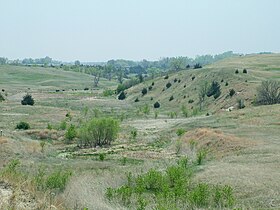Ashfall Fossil Beds
| Ashfall Fossil Beds State Historical Park |
|
| Nebraska State Historical Park | |
|
Hills surrounding the fossil beds
|
|
| Country | |
|---|---|
| State | |
| County | Antelope |
| Location | Royal |
| - coordinates | 42°25′30″N 98°09′31″W / 42.42500°N 98.15861°WCoordinates: 42°25′30″N 98°09′31″W / 42.42500°N 98.15861°W |
| Area | 360 acres (146 ha) |
| State purchase | 1987 |
| - Dedicated | 1991 |
| Management | Nebraska Game and Parks Commission |
|
Website: Ashfall Fossil Beds State Historical Park |
|
| Designated | 2006 |
The Ashfall Fossil Beds of Antelope County in northeastern Nebraska are rare fossil site types called lagerstätten that, due to extraordinary local conditions, capture a moment in time ecological "snapshot" in a range of well-preserved fossilized organisms. Ash from a Yellowstone hotspot eruption 10-12 million years ago created these fossilized bone beds.
The Ashfall Fossil Beds are especially famous for fossils of mammals from the middle Miocene geologic epoch. The Ashfall Fossil Beds are stratigraphically part of the Serravallian-ageOgallala Group.
The site is now protected as Ashfall Fossil Beds State Historical Park, which includes a visitor center with interpretive displays and working fossil preparation laboratory, and a building over an ongoing excavation site featuring fossil Teleoceras (native hippo-like ancestral rhinoceros) and ancestral horses.
The Ashfall deposit preserves the fossilized remains of ancient animals that perished in a dense volcanic ash fall which occurred during the late Miocene, approximately 12 million years ago; the animals had come to a waterhole seeking relief. The fall of ash drifted downwind from the Bruneau-Jarbidge supervolcano eruption (in present-day Idaho), nearly 1,000 miles (1,600 km) west of the Ashfall site. A large number of very well preserved fossil Teleoceras (extinct hippo-like relatives of rhinos), small three-toed and one-toed horses, camels, and birds have been excavated. Many animals were preserved with their bones articulated; one rhino still bears her unborn fetus, while others retain the contents of their last meal.
...
Wikipedia


